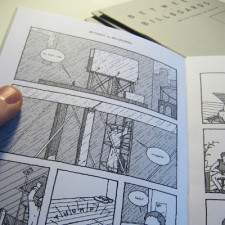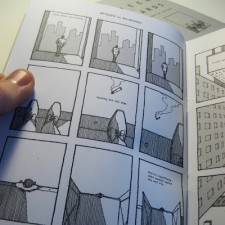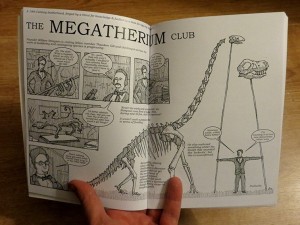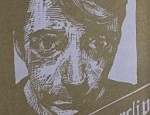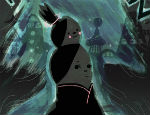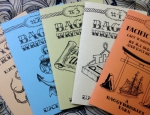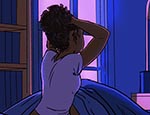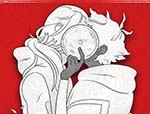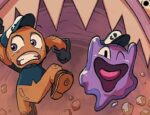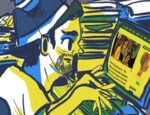Owen D. Pomery’s Between the Billboards is a remarkable debut comic with a stark and misanthropic central premise. It tells the tale of James Ebner, a recluse who has voluntarily sequestered himself from society by living between two billboards in a converted water tank on top of a building.
Last month I reviewed the book here at Broken Frontier and said “Despite the bizarre circumstances that form this book’s central foundation we’re most assuredly not looking at dark surrealist humour for its own sake here. Between the Billboards presents an urban parable on the dangers of disconnecting and the necessity of human interaction. That it does so with such a confident and distinctive voice marks its creator out as someone whose work bears close watching in the future.”
Between the Billboards is not the only current small press comics project from Owen Pomery however. The most recent issue of Avery Hill’s anthology Reads includes a preview of his upcoming The Megatherium Club; a comedic take on the exploits of a group of 19th century scientists. In today’s ‘Small Pressganged’ I speak to the man himself about architecture and comics, mad scientists, and existential selfishness…
 BROKEN FRONTIER: Before we talk about your recent and upcoming projects could you give us a little background on your path into the world of small press comics to date?
BROKEN FRONTIER: Before we talk about your recent and upcoming projects could you give us a little background on your path into the world of small press comics to date?
OWEN D. POMERY: My history in comics I would consider a very recent one, although looking back I’ve have actually been dabbling since a young age. I was obsessed with Tintin as a kid and once I’d devoured the whole series, took it upon myself to write my own. This is a pursuit I continued until I was older than I’d care to admit.
I studied architecture at university and used to doodle and write short comics to stay awake in lectures. Comic elements also turned up in my university work as well, but I never really embraced it at this stage. Moving to London I continued to draw as a hobby whilst working in architecture but had no particular aspirations to do much more with it.
However, friends were very encouraging and from what they saw, they strongly hinted that this is what I should be doing. This only really manifested itself later when I made the move from architecture into illustration and comics became something I started doing as part of that.
BF: Between the Billboards is about to reach its fifth issue. As an urban parable on the dangers of disconnecting from human interaction it has a very distinctive core concept. What were the central themes you were looking to explore when you created the reclusive James Ebner?
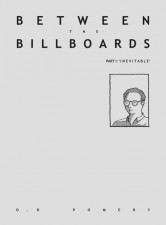 POMERY: Certainly from my point of view there is something quite appealing about disappearing into the city and being completely self-contained. I hope the reader has some envy of Ebner’s situation as well as pity for what he has become. Billboards explores what would happen if you took that way of thinking to its purest conclusion; basically you lose what you went there for in the first place, as that comfort only works when set against human interaction.
POMERY: Certainly from my point of view there is something quite appealing about disappearing into the city and being completely self-contained. I hope the reader has some envy of Ebner’s situation as well as pity for what he has become. Billboards explores what would happen if you took that way of thinking to its purest conclusion; basically you lose what you went there for in the first place, as that comfort only works when set against human interaction.
I’ve always been fascinated by the concept of what you want and what you need, both mentally and physically, to be a complete and content human. The idea of living in a manner of existential selfishness both attracts and repels me and I find the imbalance in myself an interesting phenomenon.
BF: For a first major print comics project, a six-issue series was a very ambitious decision. Now that you’re reaching the end of the Between the Billboards experience do you have any reflections on that narrative choice?
POMERY: This is very much a double-edged sword for me, I don’t regret it, but probably would not have chosen Billboards as my small press debut if I were to do it again. It was originally written as a short story, but given my illustration endeavours, it seemed crazy not to make it a graphic project. I think it was naivety that made me decide to take it on, I was unaware how quickly your style develops in those early stages. Then I found I was locked into that aesthetic for the full six issues and there are lots of other experiments I’d like to be getting on with, but I have a responsibility to complete Billboards now for everyone who’s bought a part of the series.
The other side of the coin is that I have learnt so much through doing it and I will have a complete and coherent body of work at the end of it, which I will struggle to see as anything but positive with hindsight. I.N.J. Culbard said that you can’t consider yourself a writer until you’ve completed something, regardless of how it turns out and I agree with that, there is something in the act of completion.
BF: One of the observations I made about Between the Billboards when I reviewed it at Broken Frontier was that the city itself was almost a character in its own right. How much has your obvious passion for architecture defined the comic’s world and feel?
POMERY: This is only really something I have become aware in retrospect, as I think turned my back on architecture a little too quickly at first, but there are actually so many parallels between architecture and comics. At a very basic level, it’s an understanding that your environment, in this case ‘the city’, does have an emotional effect on you and that you react to it.
As with most of my ideas, Billboards came from an architectural place, it started with the situation: would it be possible to inhabit this uninhabitable space and what does this dichotomy of being the object of observation yet never seen, say about the person who wants to live there? The rest of the story works outwards from there and I create the world around that one initial snapshot. The city features in more or less every frame of Billboards, even if it’s only in a small way and this is very important for me to create that feeling of omnipresence and immersion. It also remains unnamed, although there are elements of London and other cities mixed in there, it is deliberately anonymous while at the same time feeling very believable.
BF: Your new project The Megatherium Club was previewed in Avery Hill’s Reads #3 and is a marked departure in tone from the sobering pensiveness of Between the Billboards. Can you tell us a little about the premise of the comic, and was it a conscious decision to try your hand at something radically different now that you’re (almost) post-BTB?
POMERY: The Megatherium Club is based on a real group of amateur scientists who worked out of the Smithsonian Institute in the 19th Century and got up to various shenanigans along the way. I have distorted these characters and exaggerated their antics for the comic, but essentially I love the madness of early science and exploration and really wanted to pay homage to that.
Megatherium pretty much came about as a direct reaction to working on Billboards, it’s a heavy subject and I’m really not that dark a person. I was getting asked to contribute to a number of anthologies and I wanted a cast of characters and infinite situations I could use to generate short comedy-based one-offs. However, Avery Hill liked the concept so much they asked if I’d be interested in producing it as a full length piece.
I’d never viewed it as a full narrative but there is so much material that it would almost be a waste not to make it long form. It is far lighter in tone, but it is darkly amusing in the same way as the lighter moments of Billboards. My next big project in the pipeline is going to be pretty full on too, so it’s nice to ‘come up for air’ as it were, with something as enjoyable as The Megatherium Club.
BF: Your online graphic journal The Victory Motel is an eclectic and often darkly funny mix of webcomics and sketches detailing isolated moments in your life. To an extent there are crossover themes there with BTB in its examination of human nature. Is there something of a cathartic element to the The Victory Motel for you given its autobio comics element?
POMERY: People often ask if Billboards is autobiographical, which is slightly insulting considering it’s about a misanthropic loner! But it’s true there are some of my more extreme character traits in Ebner. I have never been completely happy with my autobio work, as I’m not overly comfortable with people knowing I am the author of some of my darker thoughts. It’s much easier to channel those ideas through a character and hide behind the fact that I may or may not be thinking those things too.
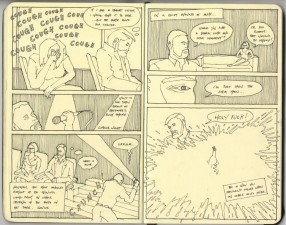 The field sketches are something I constantly do to keeps me practiced for everything else and they subconsciously feed back into and influence my comic work too. It’s a little neglected at the moment, but The Victory Motel will probably be revived the next I am on the road or need an illustration and narrative outlet to record something that’s going on in my life.
The field sketches are something I constantly do to keeps me practiced for everything else and they subconsciously feed back into and influence my comic work too. It’s a little neglected at the moment, but The Victory Motel will probably be revived the next I am on the road or need an illustration and narrative outlet to record something that’s going on in my life.
BF: Will The Megatherium Club be your main focus in the short-term future or do you have any other comics-related projects in the planning stages?
POMERY: The Megatherium Club is the priority at the moment, but very soon after I will be wrapping up the Billboards saga. I also have a few anthology pieces coming out in ink+PAPER, The Newcastle Science Comic and Mike Medaglia’s Wu Wei. In the background I am planning a much larger project called British Ice which is set to take years off my life, but something I am very excited to produce.
BF: And, finally, across the rest of the small press community what work has particularly caught your eye of late? What in your opinion should we definitely be sticking on our self-published “must-read” lists?
POMERY: Simon Moreton (Smoo Comics) and Joe Decie (The Accidental Salad) are probably the reason I backed off autobio, between them they’ve got the genre dialled for me. Moreton hunting down the very meaning of being, while Decie acknowledging the frivolous and surreal side of thought – great stuff.
Dave ‘Lando’ Lander of Decadence is still knocking it out the park in terms of his artwork; his quality of line is unreal and deserves far more recognition.
I admire Douglas Noble’s persistent pursuit of experimentation, which is a reminder not to become blinkered and sometimes you need to roll the dice a little more.
Andy Poyiadgi is new one for me, but what I’ve seen looks very impressive, looking forward to see where he goes with it.
For more on Owen’s work check out his website here. You can order copies of Between the Billboards from his online store here. Reads #3 featuring The Megatherium Club preview is available from Avery Hill Publishing here.





